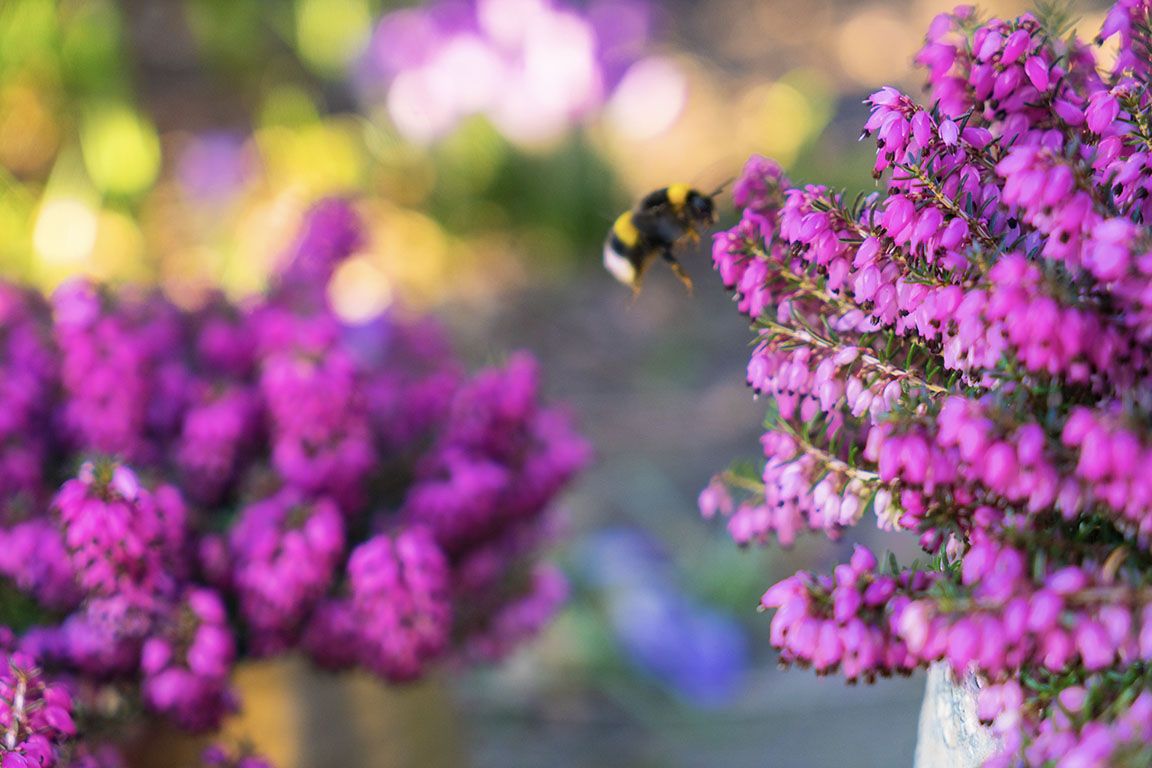
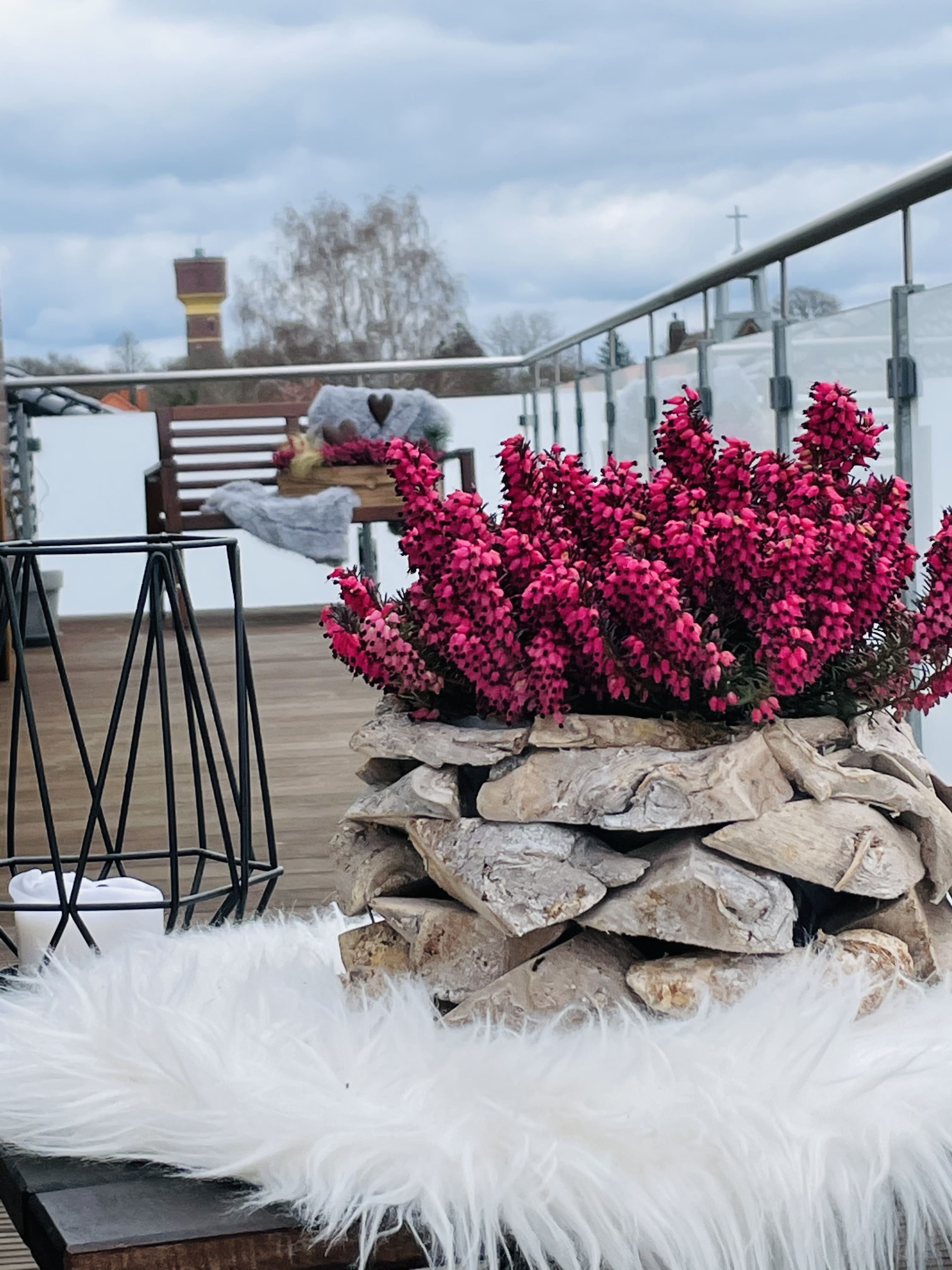
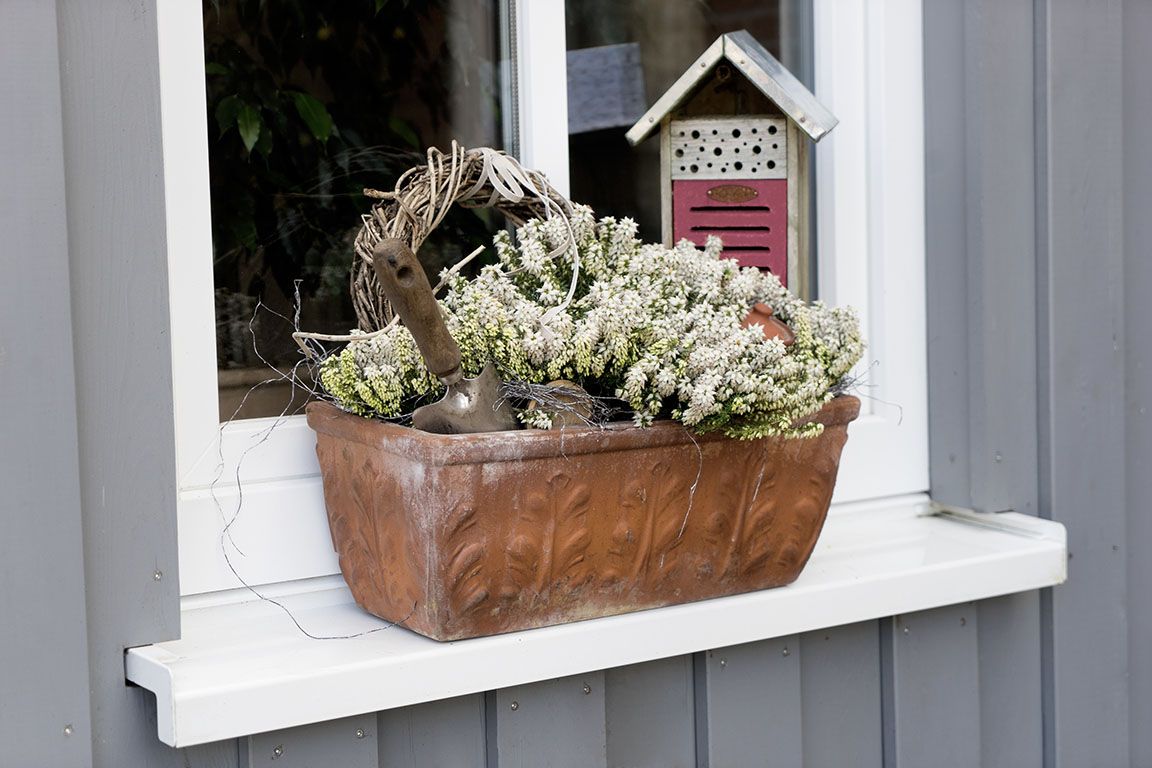

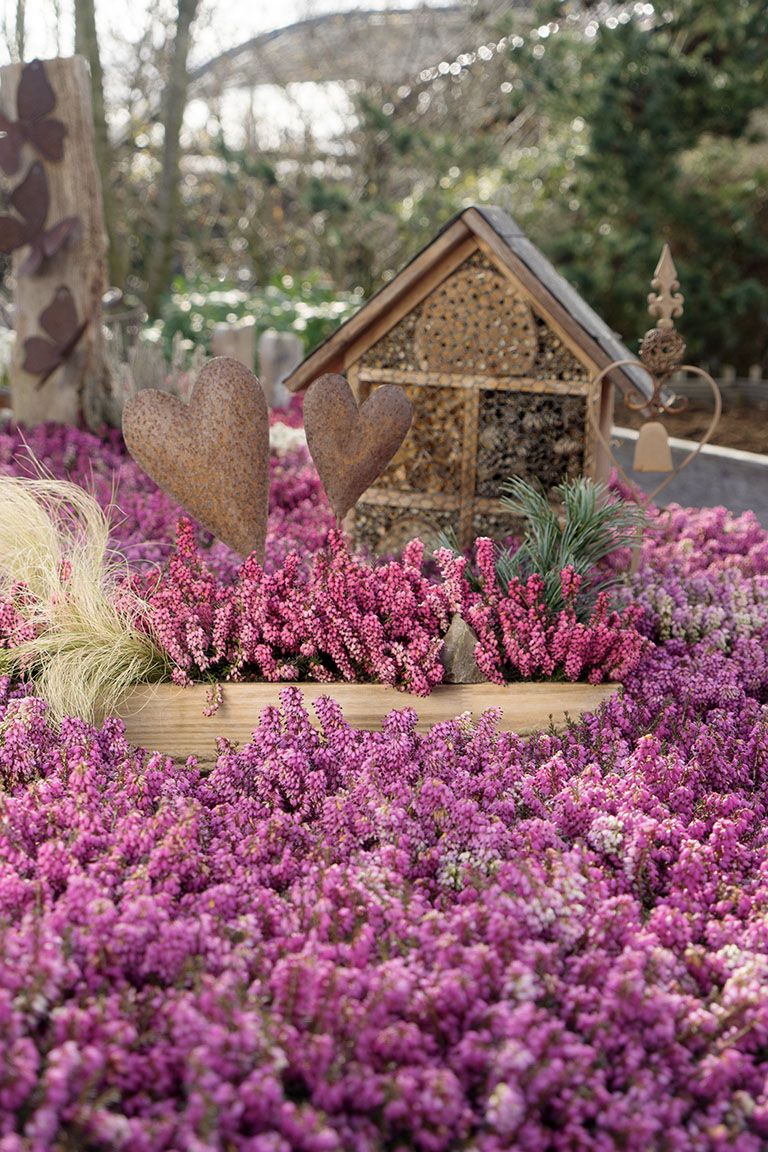
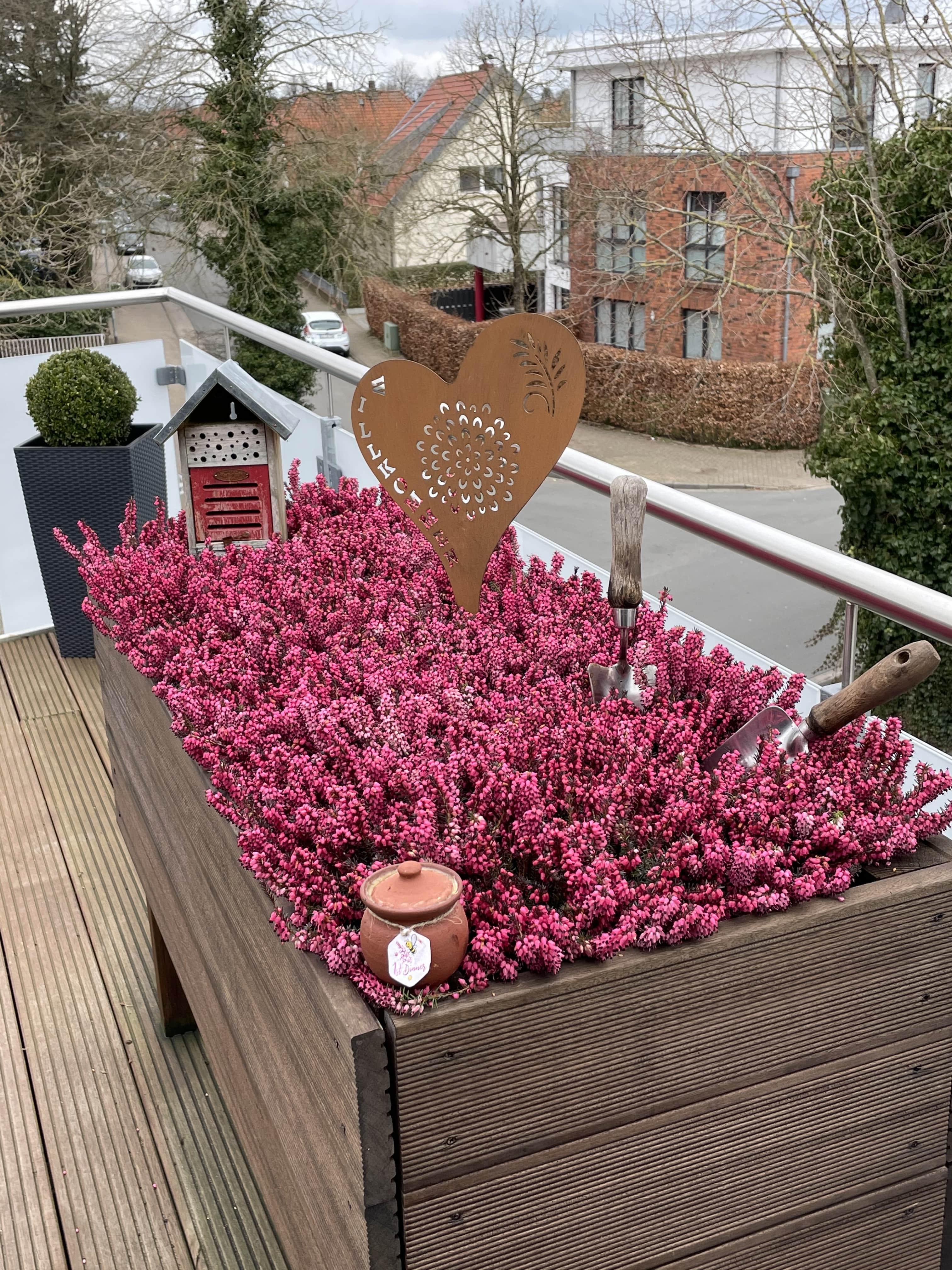
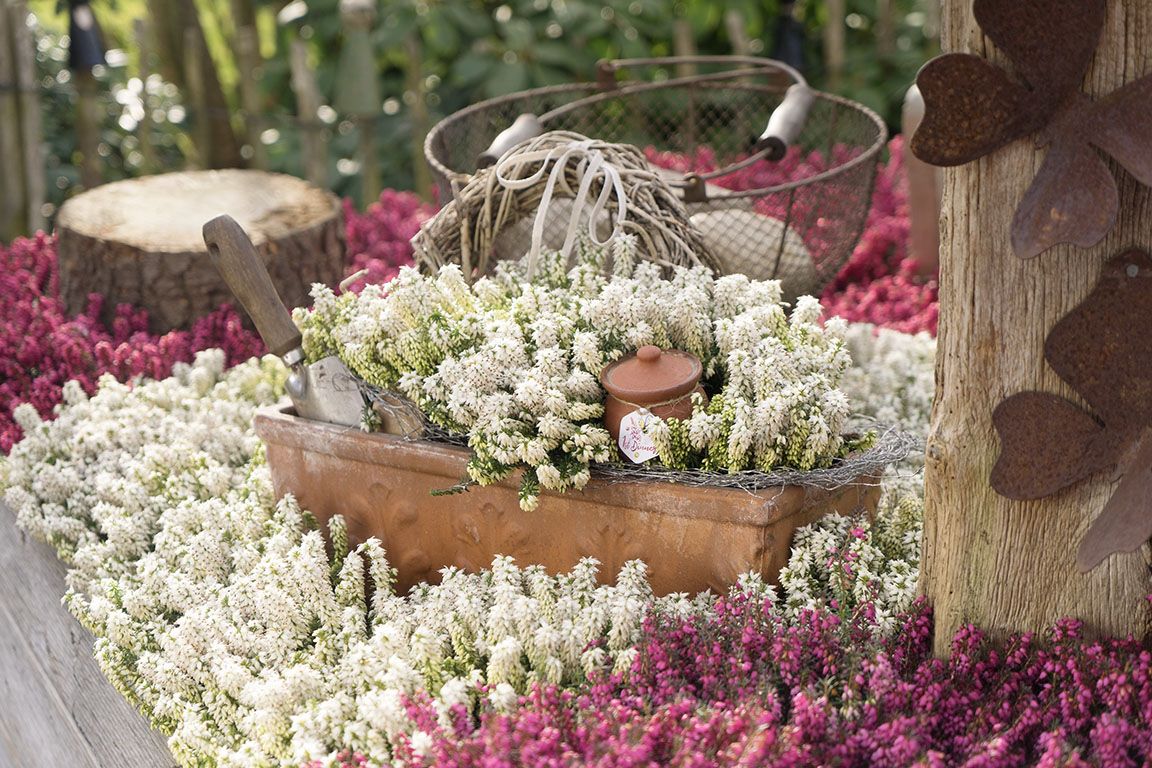

The Snow Heather (Erica carnea) develops its full flower power, when all other plants are in deep winter rest. Plants can tolerate lime a little bit better than other heathers. Spring-flowering heathers like the winter-hardy Erica species can be pruned back after flowering – in spring. They just need to get cut back in shape with a sharp scissor. This heather is a very important source of food, especially for bees which supplies food with as one of the first plants of the year (highest bee nutrition class 4). It also provides a source of food for numerous insects and butterflies. Winterhardy Erika varieties thus fulfill an important ecological function.








The English heather is very floriferous and shows colour over the entire flowering time. Plants grow up to 30-40 cm in diameter and a bit taller than the Snow Heather. Unlike Erica carnea, this species is only winter-hardy in protected areas. Provide winter protection, for example with fir branches. Snow covers will insulate the plants.
Snow Heather and this English Heather are one of the earliest fodder plants for bees in the year flowering from November to May depending on the variety.
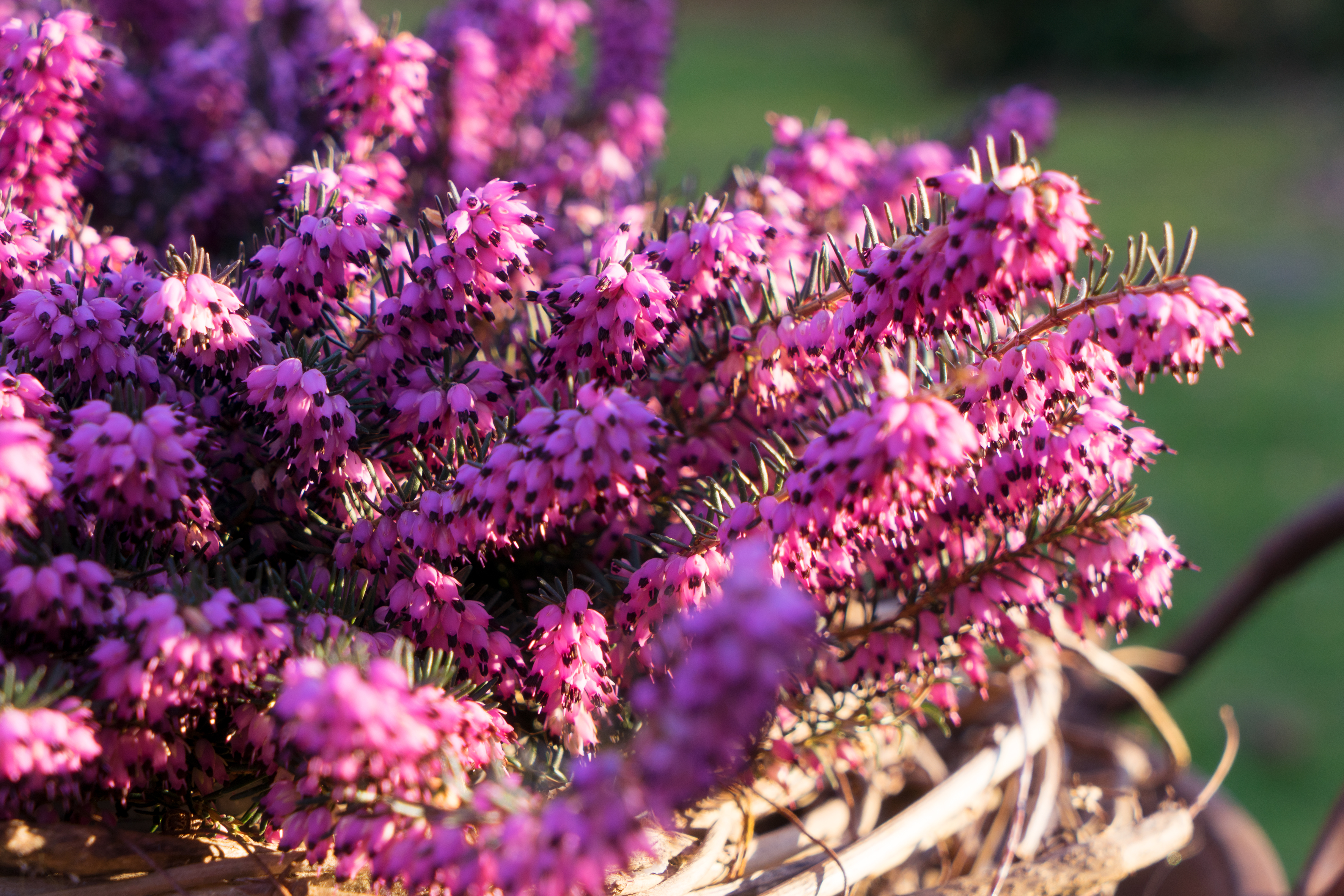
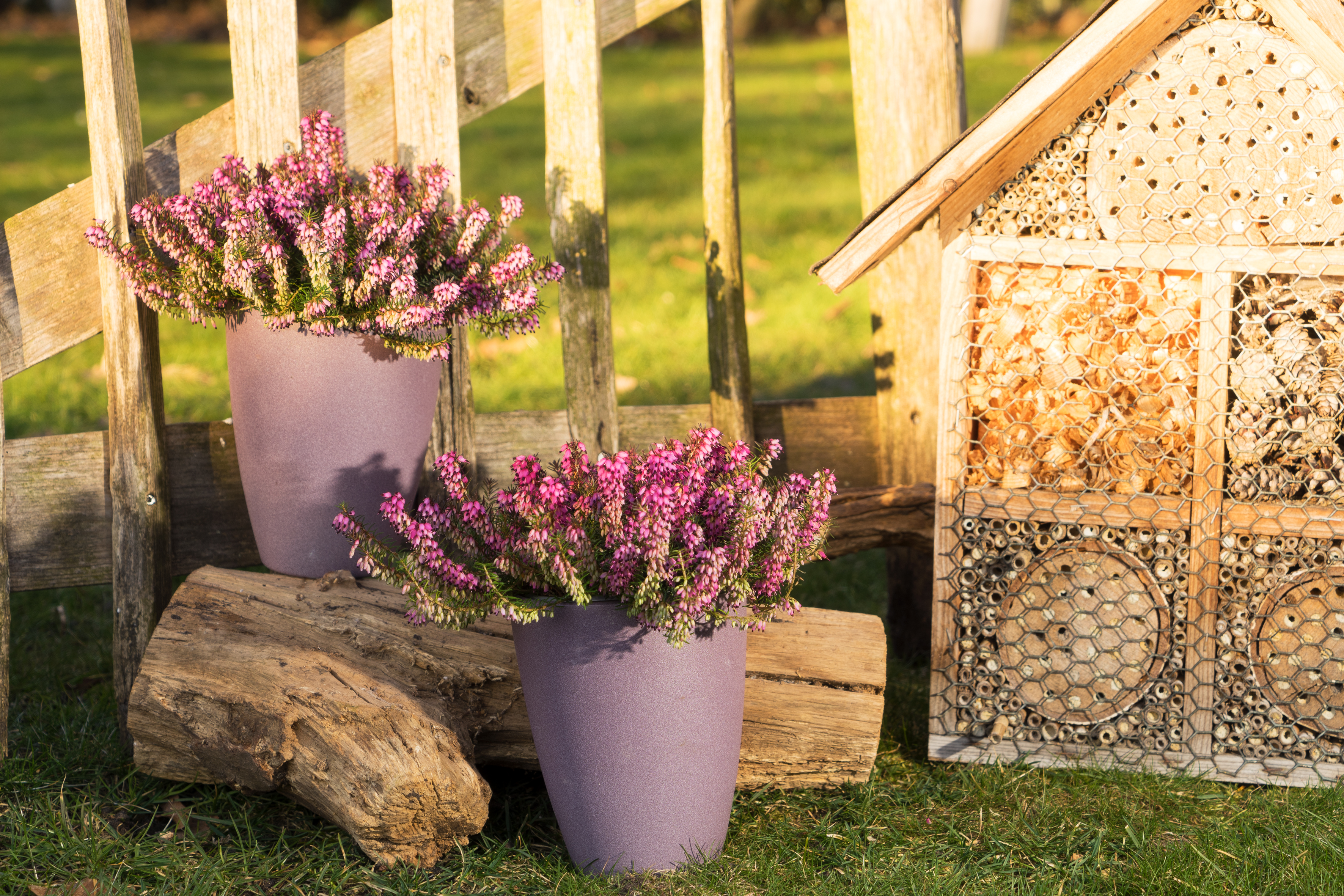


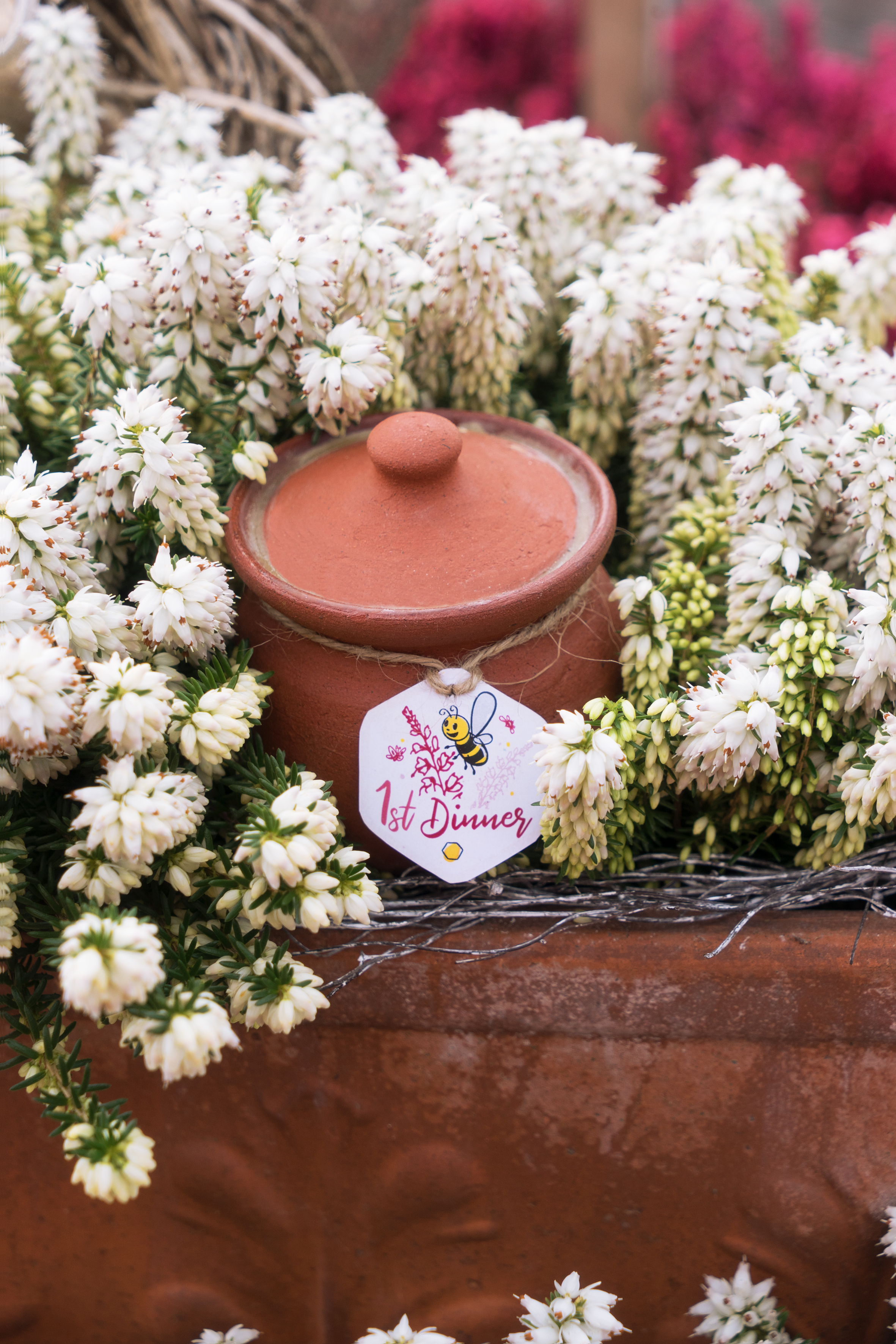

Daboecia or Irish Bell Heather is flowering in summer and grows bushy and compact. The growth habit varies from variety to variety, but can reach 50 cm in height and 35 cm in width. The countless attractive bell-shaped flowers are flowering from July well into autumn. You might want to remove the spent flower branches to encourage a second set of flowers later in the season. The preferred location is a sunny garden spot with well-drained, slightly acid soil with a pH of 4-4, 5. Daboecia is highly attractive to bumble-bees and other pollinating insects. Avoid water-logging or severe drought. Plants are only winter-hardy in protected areas. Provide winter protection, for example with fir branches.
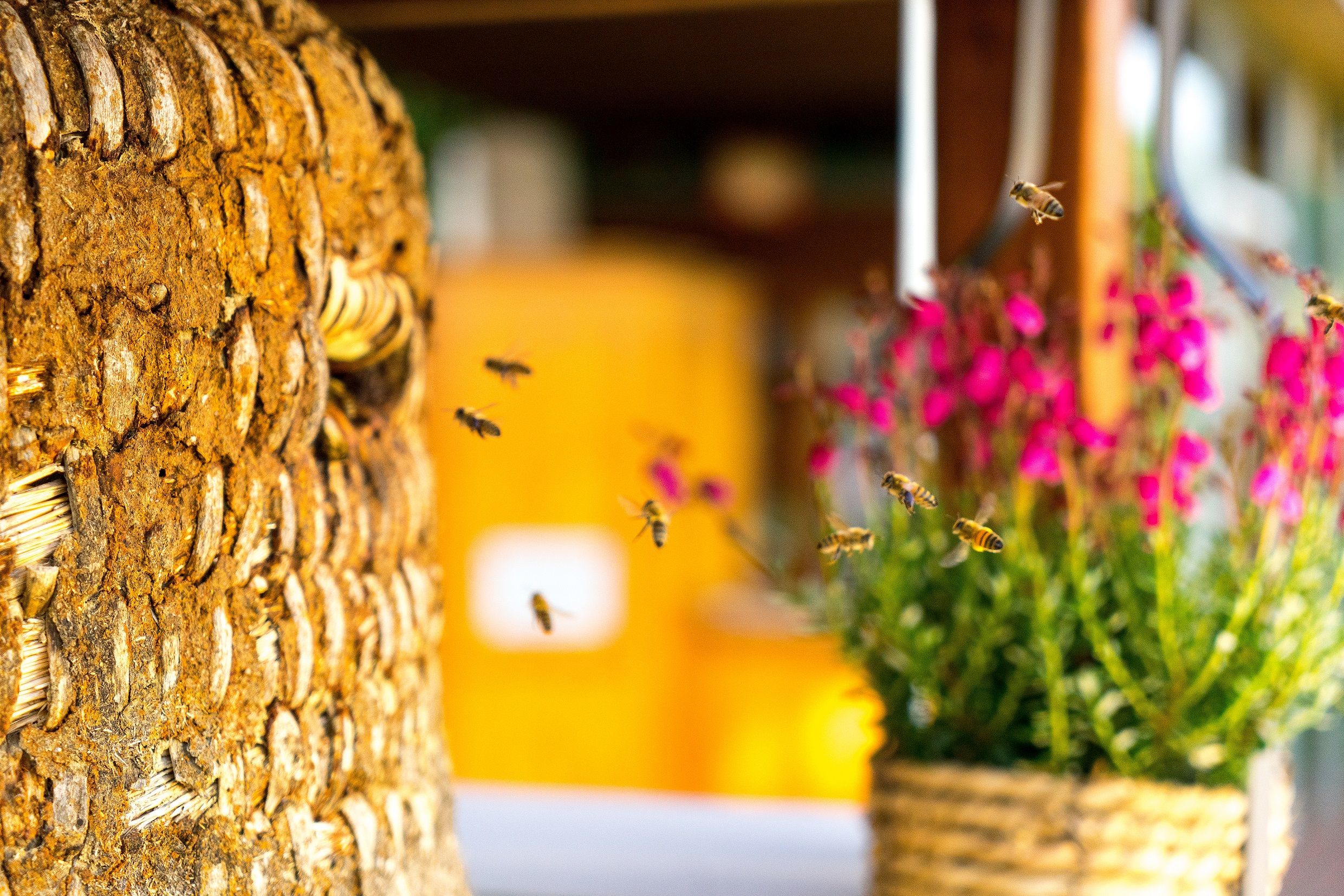
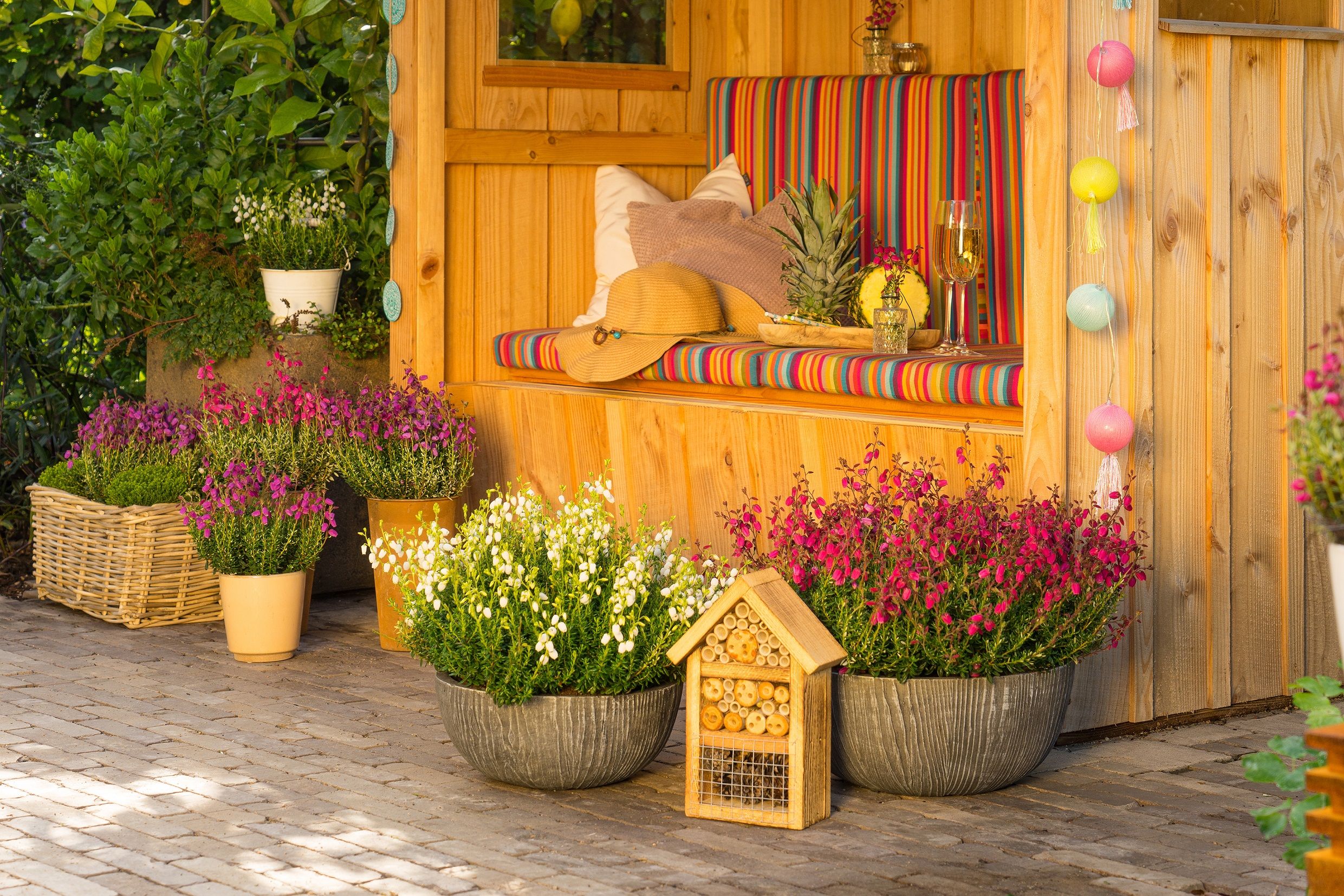
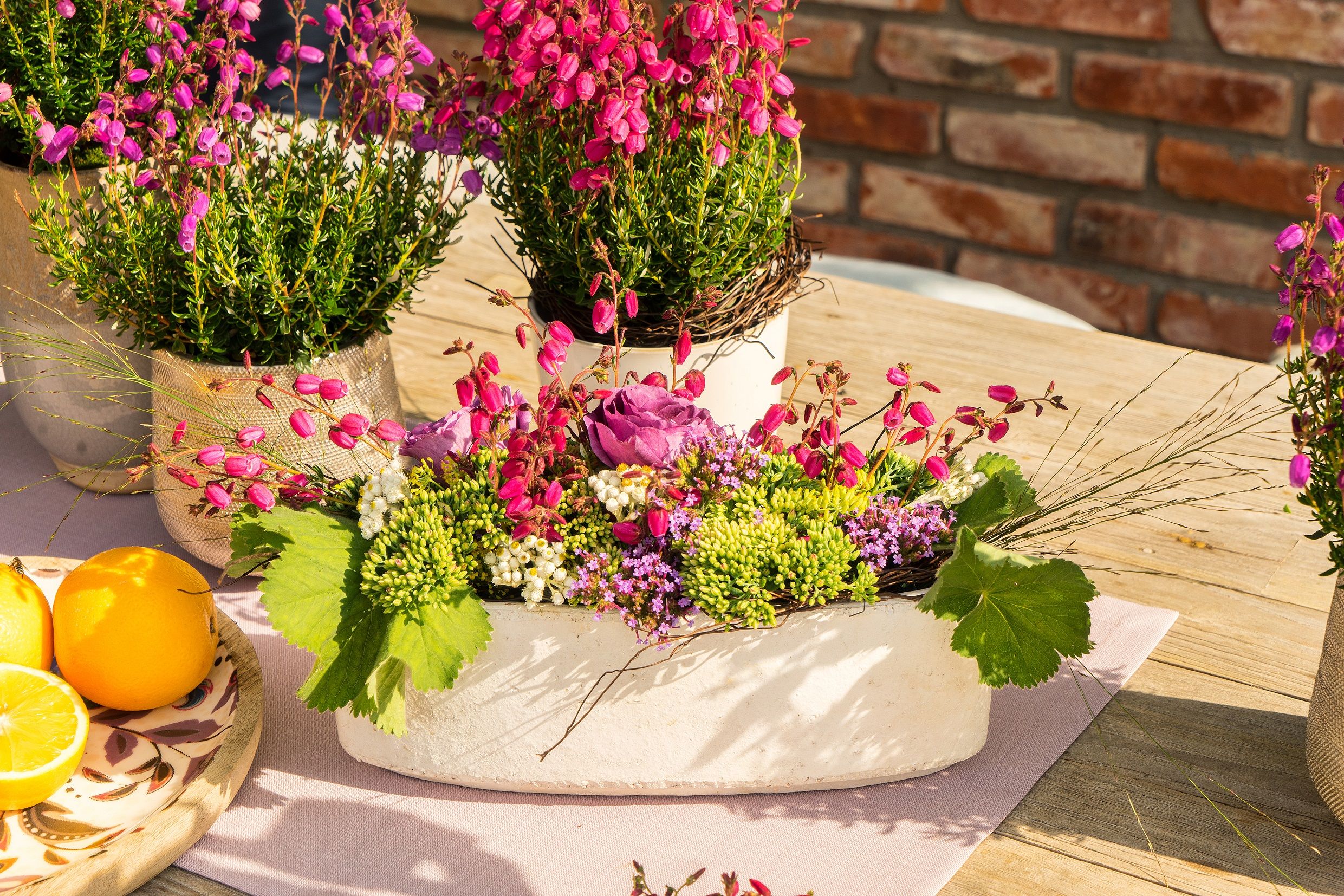
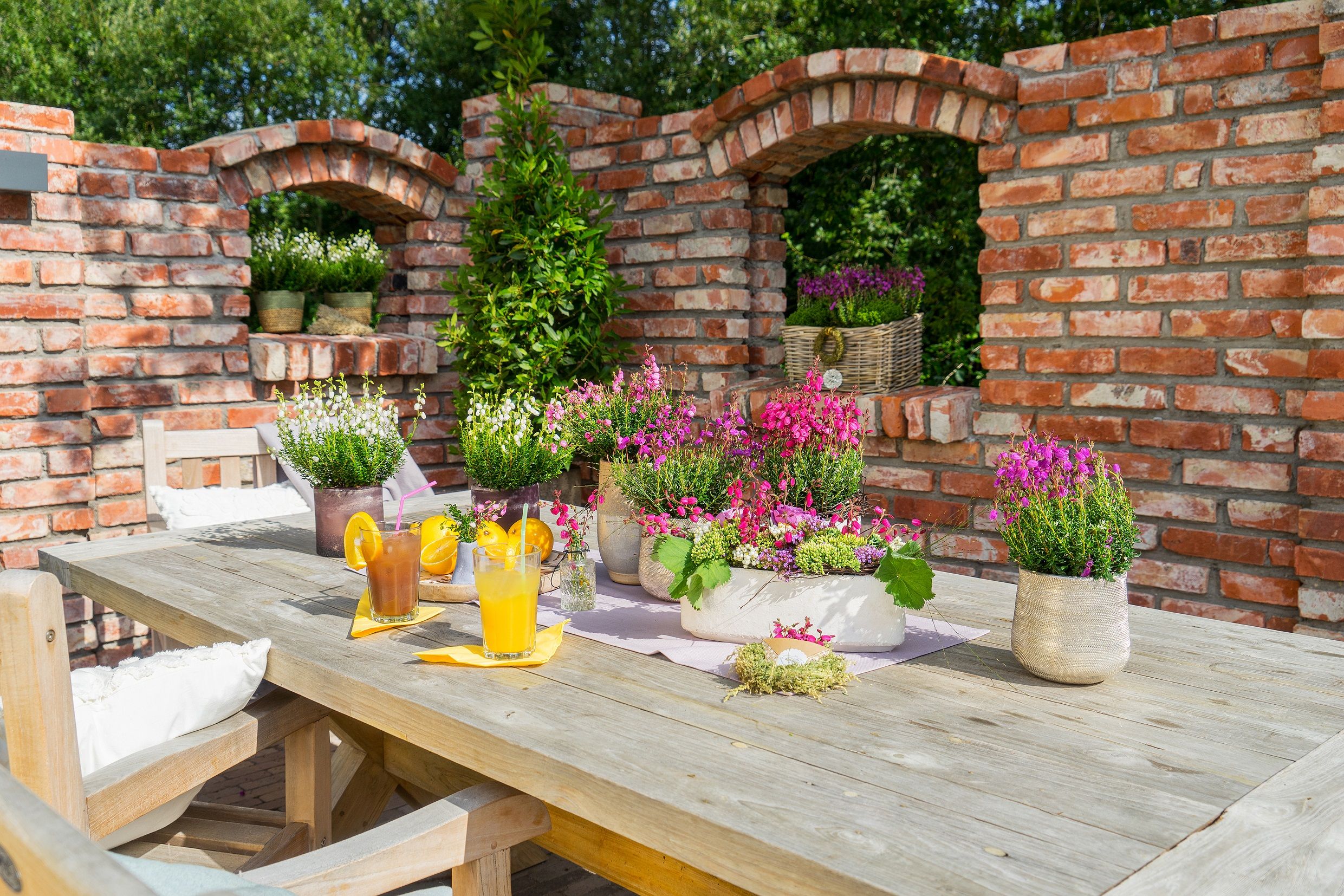
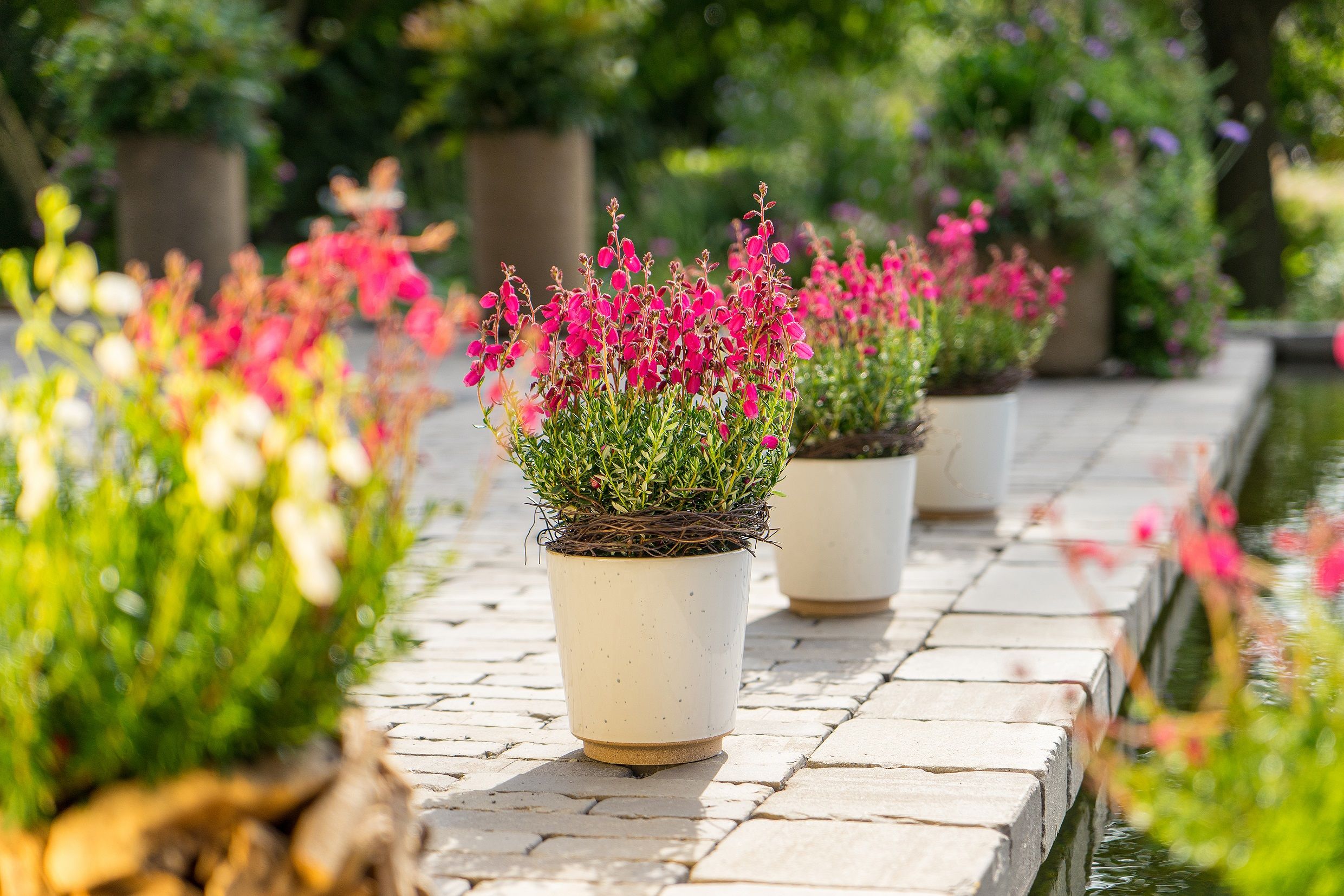
The Cinerea Bell heather comes to the fore with new fresh and exciting colors. From July, it sets accents and marks the start of the fall season. Its brightly colored bells also provide an excellent
an excellent source of food for our pollinating insects.
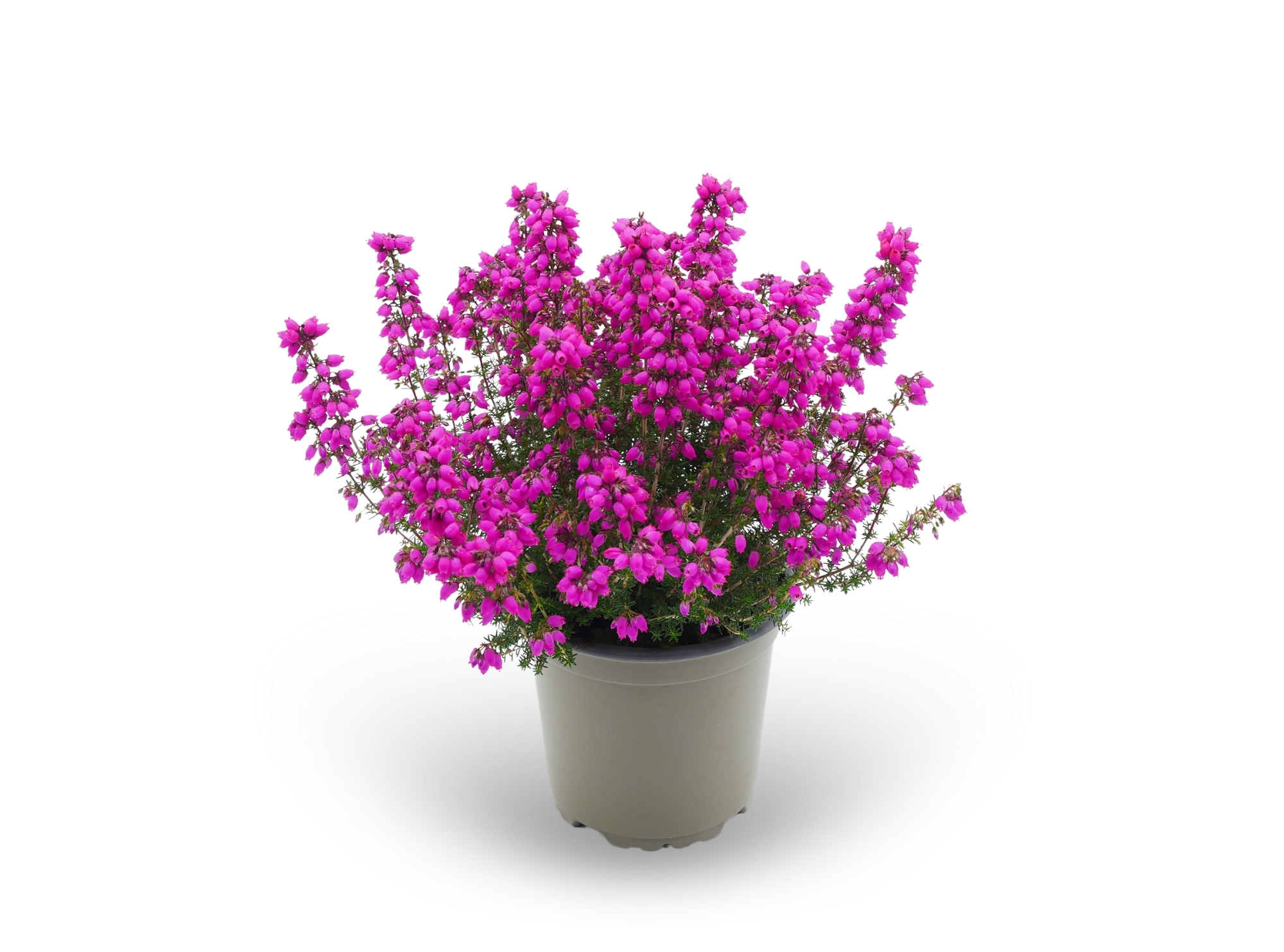
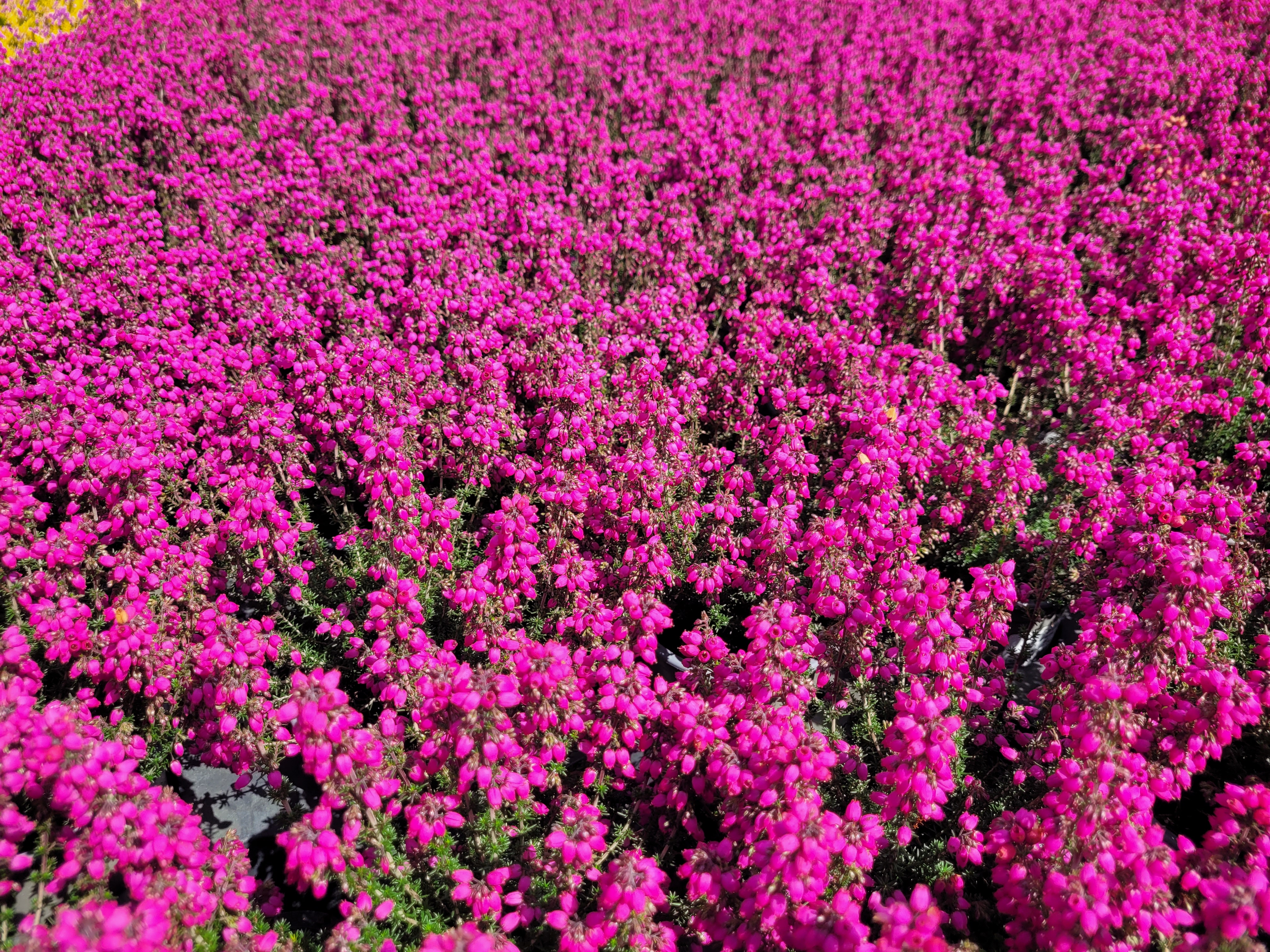
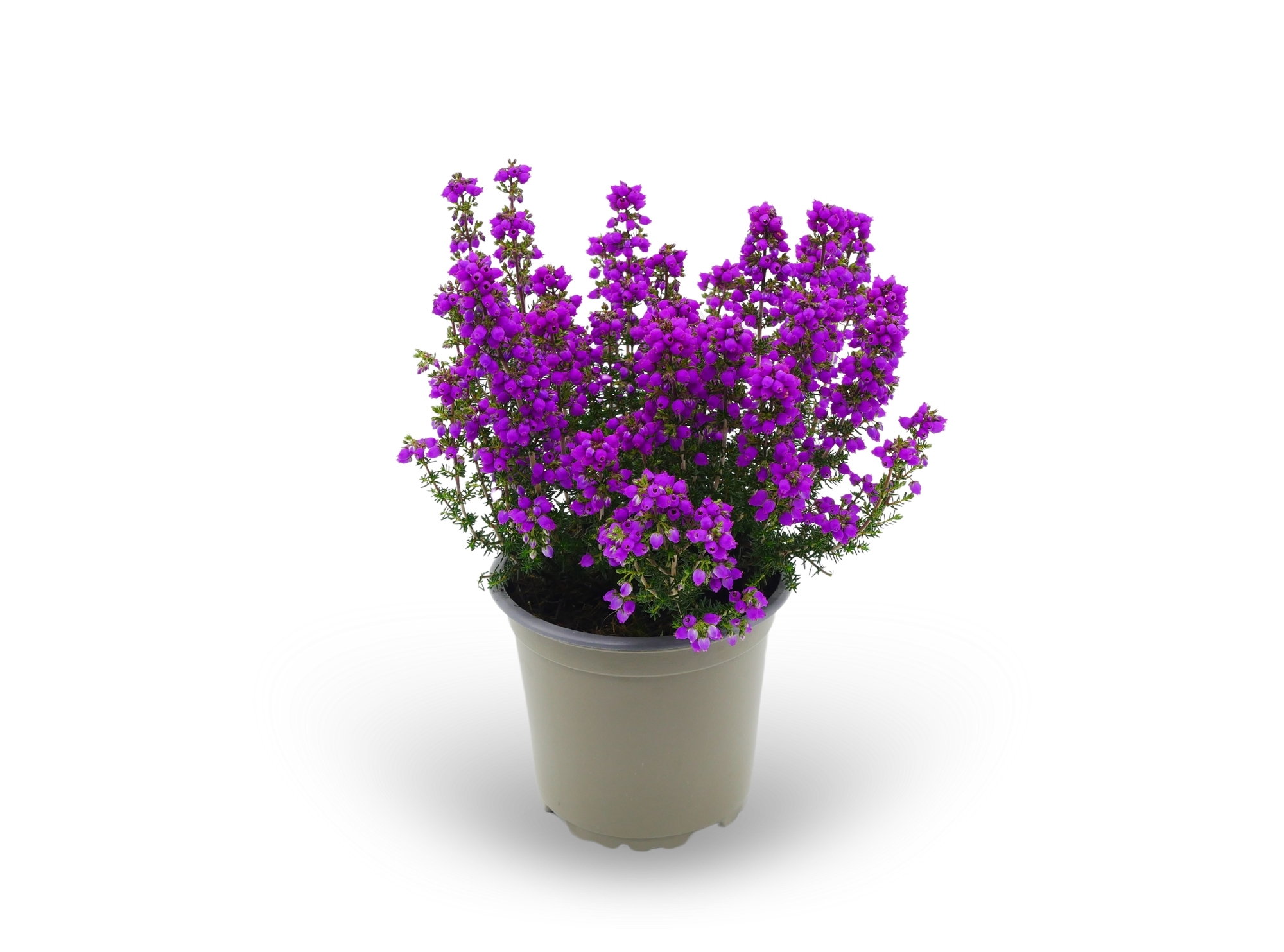


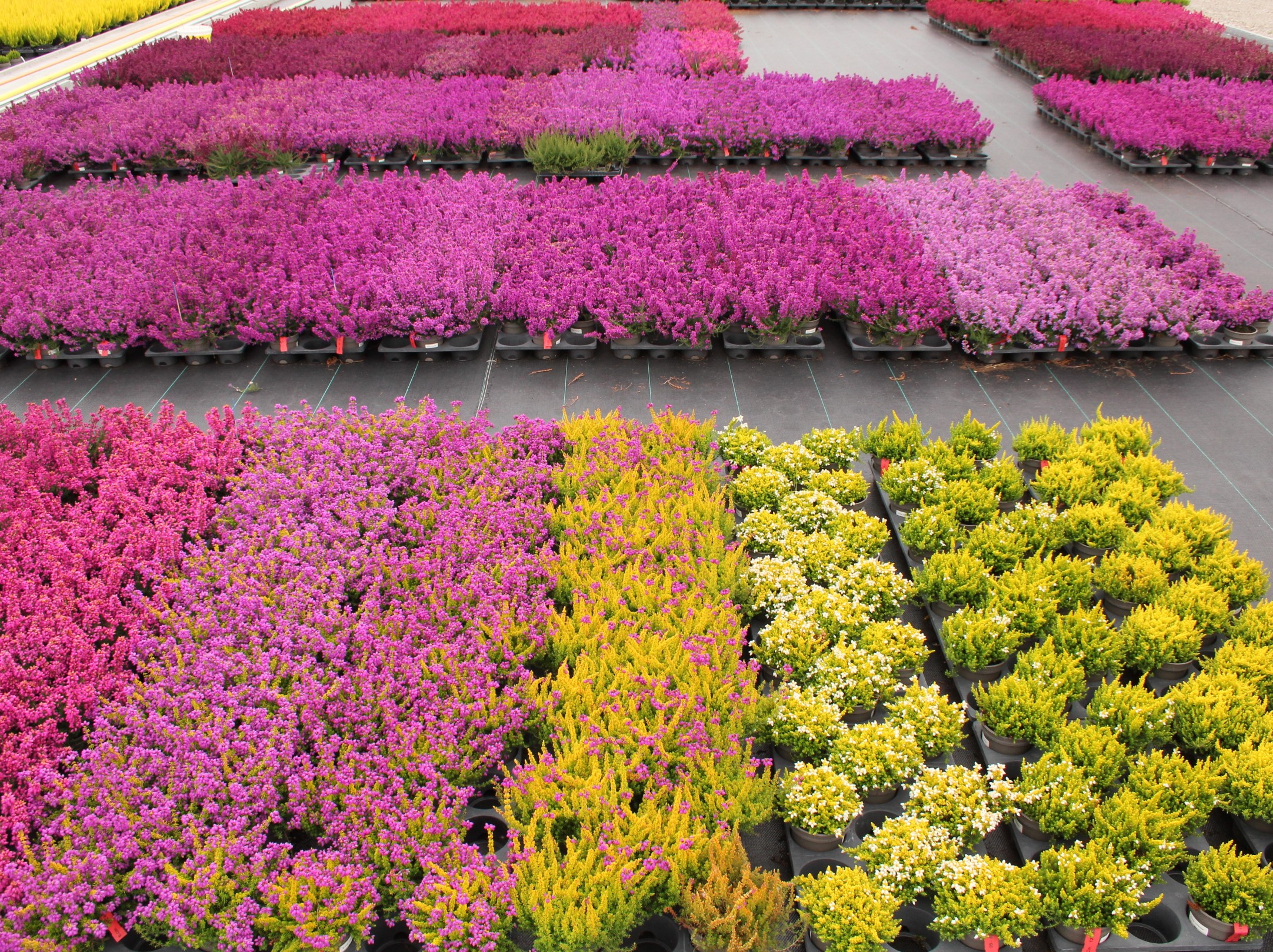
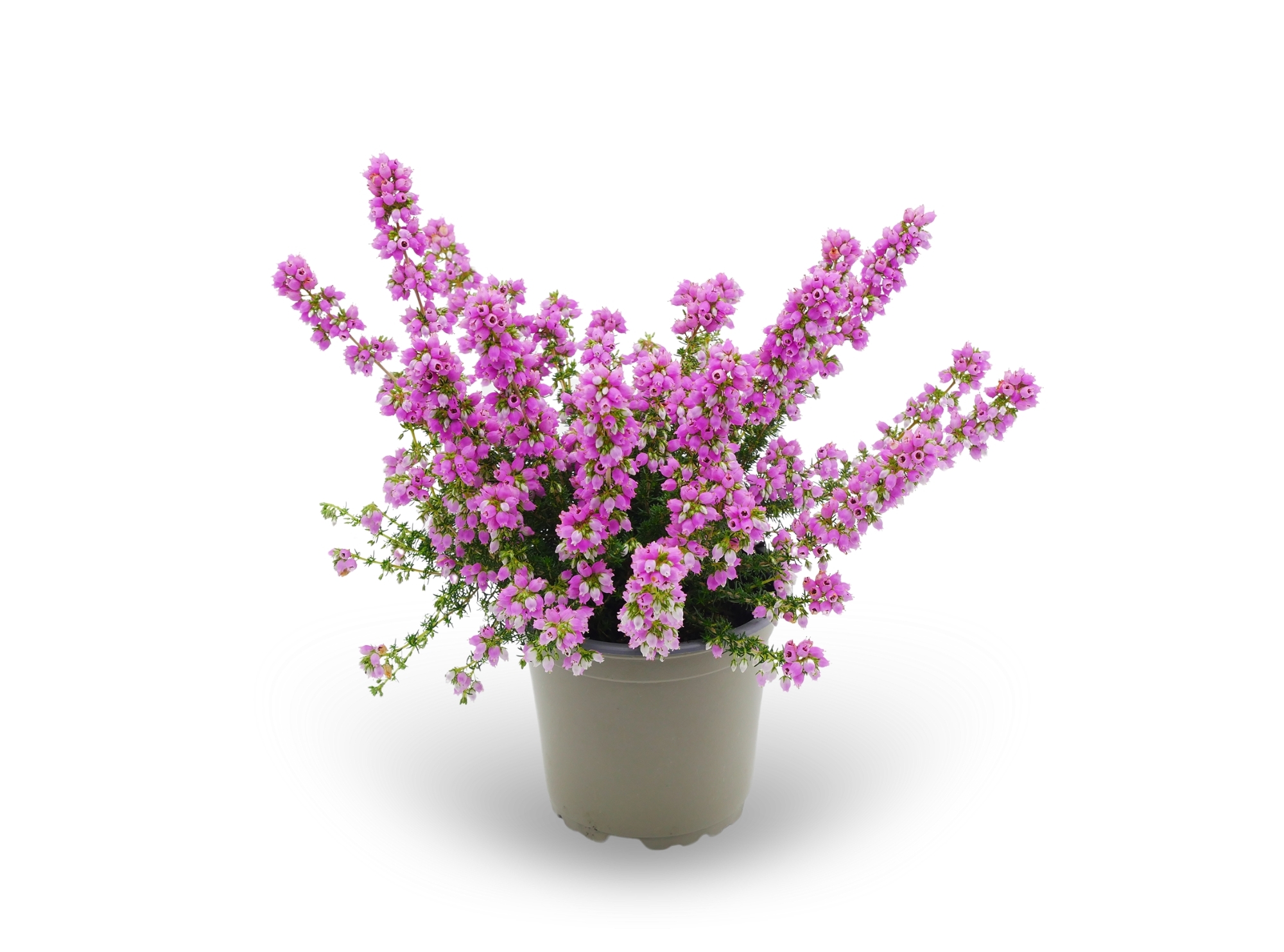
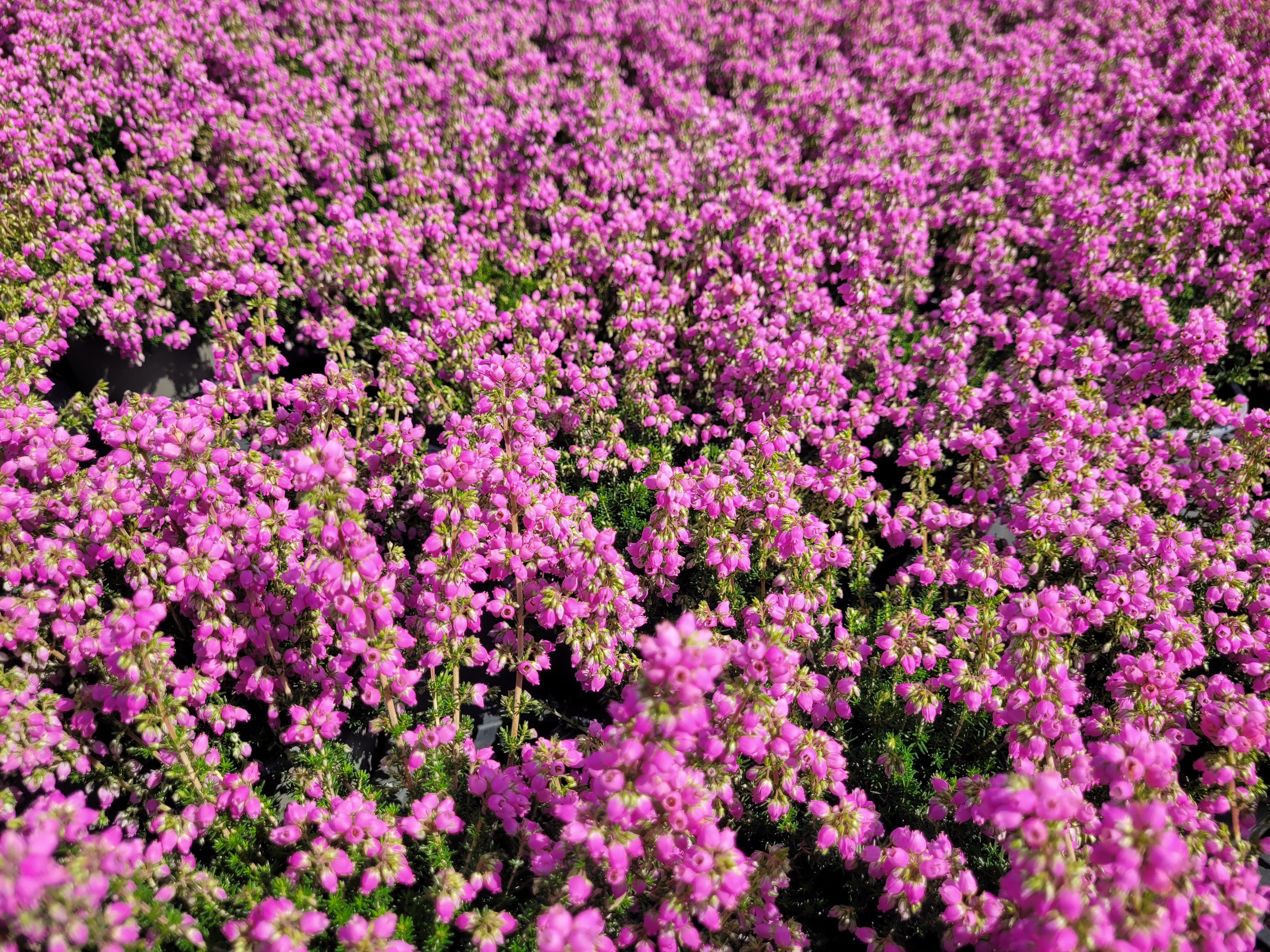

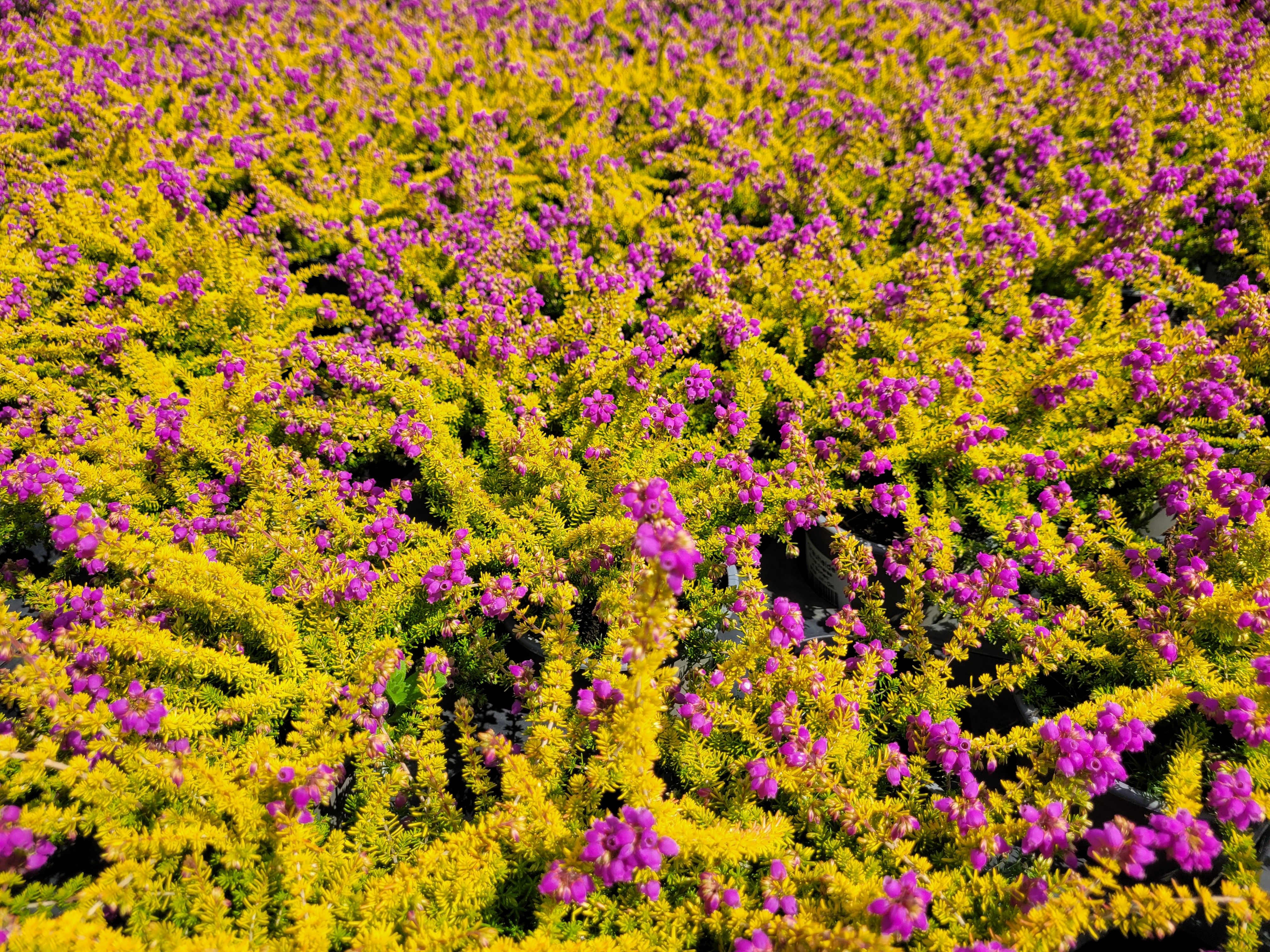
We use cookies to provide you with the best website experience. Cookies are sometimes necessary for the operation of the site. Others are used, among other things, for anonymous statistical purposes or to improve the user-friendliness. Depending on your settings, you may not be able to use the full functionality of the site. You can find further information in our Privicy notices.
These cookies are absolutely necessary for the operation of the site and enable, for example, security-relevant functions.
In order to improve our website and the product display experience, we collect anonymised data for statistics and analysis. With the help of these cookies, we can, for example, determine the number of visitors and the effect of certain pages of our website and optimise our content for you accordingly.
We use these cookies to make it easier for you to use the site and to share and remember content. For example, you can add products to your Pinterest board as inspiration directly from our site.
The following information will provide you with an easy to navigate overview of what will happen with your personal data when you visit this website. The term “personal data” comprises all data that can be used to personally identify you. For detailed information about the subject matter of data protection, please consult our Data Protection Declaration, which we have included beneath this copy.
Who is the responsible party for the recording of data on this website (i.e. the “controller”)?
The data on this website is processed by the operator of the website, whose contact information is available under section “Information Required by Law” on this website.
How do we record your data?
We collect your data as a result of your sharing of your data with us. This may, for instance be information you enter into our contact form.
Other data shall be recorded by our IT systems automatically or after you consent to its recording during your website visit. This data comprises primarily technical information (e.g. web browser, operating system or time the site was accessed). This information is recorded automatically when you access this website.
What are the purposes we use your data for?
A portion of the information is generated to guarantee the error free provision of the website. Other data may be used to analyze your user patterns.
What rights do you have as far as your information is concerned?
You have the right to receive information about the source, recipients and purposes of your archived personal data at any time without having to pay a fee for such disclosures. You also have the right to demand that your data are rectified or eradicated. If you have consented to data processing, you have the option to revoke this consent at any time, which shall affect all future data processing. Moreover, you have the right to demand that the processing of your data be restricted under certain circumstances. Furthermore, you have the right to log a complaint with the competent supervising agency.
Please do not hesitate to contact us at any time under the address disclosed in section “Information Required by Law” on this website if you have questions about this or any other data protection related issues.
There is a possibility that your browsing patterns will be statistically analyzed when your visit this website. Such analyses are performed primarily with what we refer to as analysis programs.
For detailed information about these analysis programs please consult our Data Protection Declaration below.
This website is hosted by an external service provider (host). Personal data collected on this website are stored on the servers of the host. These may include, but are not limited to, IP addresses, contact requests, metadata and communications, contract information, contact information, names, web page access, and other data generated through a web site.
The host is used for the purpose of fulfilling the contract with our potential and existing customers (Art. 6 para. 1 lit. b GDPR) and in the interest of secure, fast and efficient provision of our online services by a professional provider (Art. 6 para. 1 lit. f GDPR).
Our host will only process your data to the extent necessary to fulfil its performance obligations and to follow our instructions with respect to such data.
Execution of a contract data processing agreement
In order to guarantee processing in compliance with data protection regulations, we have concluded an order processing contract with our host.
The operators of this website and its pages take the protection of your personal data very seriously. Hence, we handle your personal data as confidential information and in compliance with the statutory data protection regulations and this Data Protection Declaration.
Whenever you use this website, a variety of personal information will be collected. Personal data comprises data that can be used to personally identify you. This Data Protection Declaration explains which data we collect as well as the purposes we use this data for. It also explains how, and for which purpose the information is collected.
We herewith advise you that the transmission of data via the Internet (i.e. through e-mail communications) may be prone to security gaps. It is not possible to completely protect data against third party access.
The data processing controller on this website is:
Gardengirls Heidezüchtung GmbH
Claus Geißler
Wasserschwenden 3
D-87452 Altusried
Phone: +49 (0) 44 05 – 81 92
E-mail: info@gardengirls.de
The controller is the natural person or legal entity that single-handedly or jointly with others makes decisions as to the purposes of and resources for the processing of personal data (e.g. names, e-mail addresses, etc.).
A wide range of data processing transactions are possible only subject to your express consent. You can also revoke at any time any consent you have already given us. This shall be without prejudice to the lawfulness of any data collection that occurred prior to your revocation.
IN THE EVENT THAT DATA ARE PROCESSED ON THE BASIS OF ART. 6 SECT. 1 LIT. E OR F GDPR, YOU HAVE THE RIGHT TO AT ANY TIME OBJECT TO THE PROCESSING OF YOUR PERSONAL DATA BASED ON GROUNDS ARISING FROM YOUR UNIQUE SITUATION. THIS ALSO APPLIES TO ANY PROFILING BASED ON THESE PROVISIONS. TO DETERMINE THE LEGAL BASIS, ON WHICH ANY PROCESSING OF DATA IS BASED, PLEASE CONSULT THIS DATA PROTECTION DECLARATION. IF YOU LOG AN OBJECTION, WE WILL NO LONGER PROCESS YOUR AFFECTED PERSONAL DATA, UNLESS WE ARE IN A POSITION TO PRESENT COMPELLING PROTECTION WORTHY GROUNDS FOR THE PROCESSING OF YOUR DATA, THAT OUTWEIGH YOUR INTERESTS, RIGHTS AND FREEDOMS OR IF THE PURPOSE OF THE PROCESSING IS THE CLAIMING, EXERCISING OR DEFENCE OF LEGAL ENTITLEMENTS (OBJECTION PURSUANT TO ART. 21 SECT. 1 GDPR).
IF YOUR PERSONAL DATA IS BEING PROCESSED IN ORDER TO ENGAGE IN DIRECT ADVERTISING, YOU HAVE THE RIGHT TO AT ANY TIME OBJECT TO THE PROCESSING OF YOUR AFFECTED PERSONAL DATA FOR THE PURPOSES OF SUCH ADVERTISING. THIS ALSO APPLIES TO PROFILING TO THE EXTENT THAT IT IS AFFILIATED WITH SUCH DIRECT ADVERTISING. IF YOU OBJECT, YOUR PERSONAL DATA WILL SUBSEQUENTLY NO LONGER BE USED FOR DIRECT ADVERTISING PURPOSES (OBJECTION PURSUANT TO ART. 21 SECT. 2 GDPR).
In the event of violations of the GDPR, data subjects are entitled to log a complaint with a supervisory agency, in particular in the member state where they usually maintain their domicile, place of work or at the place where the alleged violation occurred. The right to log a complaint is in effect regardless of any other administrative or court proceedings available as legal recourses.
You have the right to demand that we hand over any data we automatically process on the basis of your consent or in order to fulfil a contract be handed over to you or a third party in a commonly used, machine readable format. If you should demand the direct transfer of the data to another controller, this will be done only if it is technically feasible.
For security reasons and to protect the transmission of confidential content, such as purchase orders or inquiries you submit to us as the website operator, this website uses either an SSL or a TLS encryption program. You can recognize an encrypted connection by checking whether the address line of the browser switches from “http://” to “https://” and also by the appearance of the lock icon in the browser line.
If the SSL or TLS encryption is activated, data you transmit to us cannot be read by third parties.
Within the scope of the applicable statutory provisions, you have the right to at any time demand information about your archived personal data, their source and recipients as well as the purpose of the processing of your data. You may also have a right to have your data rectified or eradicated. If you have questions about this subject matter or any other questions about personal data, please do not hesitate to contact us at any time at the address provided in section “Information Required by Law.”
You have the right to demand the imposition of restrictions as far as the processing of your personal data is concerned. To do so, you may contact us at any time at the address provided in section “Information Required by Law.” The right to demand restriction of processing applies in the following cases:
If you have restricted the processing of your personal data, these data – with the exception of their archiving – may be processed only subject to your consent or to claim, exercise or defend legal entitlements or to protect the rights of other natural persons or legal entities or for important public interest reasons cited by the European Union or a member state of the EU.
Our websites and pages use what the industry refers to as “cookies.” Cookies are small text files that do not cause any damage to your device. They are either stored temporarily for the duration of a session (session cookies) or they are permanently archived on your device (permanent cookies). Session cookies are automatically deleted once you terminate your visit. Permanent cookies remain archived on your device until you actively delete them or they are automatically eradicated by your web browser.
In some cases it is possible that third party cookies are stored on your device once you enter our site (third party cookies). These cookies enable you or us to take advantage of certain services offered by the third party (e.g. cookies for the processing of payment services).
Cookies have a variety of functions. Many cookies are technically essential since certain website functions would not work in the absence of the cookies (e.g. the shopping cart function or the display of videos). The purpose of other cookies may be the analysis of user patterns or the display of promotional messages.
Cookies, which are required for the performance of electronic communication transactions (required cookies) or for the provision of certain functions you want to use (functional cookies, e.g. for the shopping cart function) or those that are necessary for the optimization of the website (e.g. cookies that provide measurable insights into the web audience), shall be stored on the basis of Art. 6 Sect. 1 lit. f GDPR, unless a different legal basis is cited. The operator of the website has a legitimate interest in the storage of cookies to ensure the technically error free and optimized provision of the operator’s services. If your consent to the storage of the cookies has been requested, the respective cookies are stored exclusively on the basis of the consent obtained (Art. 6 Sect. 1 lit. a GDPR); this consent may be revoked at any time.
You have the option to set up your browser in such a manner that you will be notified any time cookies are placed and to permit the acceptance of cookies only in specific cases. You may also exclude the acceptance of cookies in certain cases or in general or activate the delete function for the automatic eradication of cookies when the browser closes. If cookies are deactivated, the functions of this website may be limited.
In the event that third party cookies are used or if cookies are used for analytical purposes, we will separately notify you in conjunction with this Data Protection Policy and, if applicable, ask for your consent.
The provider of this website and its pages automatically collects and stores information in so-called server log files, which your browser communicates to us automatically. The information comprises:
This data is not merged with other data sources.
This data is recorded on the basis of Art. 6 Sect. 1 lit. f GDPR. The operator of the website has a legitimate interest in the technically error free depiction and the optimization of the operator’s website. In order to achieve this, server log files must be recorded.
If you submit inquiries to us via our contact form, the information provided in the contact form as well as any contact information provided therein will be stored by us in order to handle your inquiry and in the event that we have further questions. We will not share this information without your consent.
The processing of these data is based on Art. 6 para. 1 lit. b GDPR, if your request is related to the execution of a contract or if it is necessary to carry out pre-contractual measures. In all other cases the processing is based on our legitimate interest in the effective processing of the requests addressed to us (Art. 6 Para. 1 lit. f GDPR) or on your agreement (Art. 6 Para. 1 lit. a GDPR) if this has been requested.
The information you have entered into the contact form shall remain with us until you ask us to eradicate the data, revoke your consent to the archiving of data or if the purpose for which the information is being archived no longer exists (e.g. after we have concluded our response to your inquiry). This shall be without prejudice to any mandatory legal provisions – in particular retention periods.
If you contact us by e-mail, telephone or fax, your request, including all resulting personal data (name, request) will be stored and processed by us for the purpose of processing your request. We do not pass these data on without your consent.
These data are processed on the basis of Art. 6 Sect. 1 lit. b GDPR if your inquiry is related to the fulfillment of a contract or is required for the performance of pre-contractual measures. In all other cases, the data are processed on the basis of our legitimate interest in the effective handling of inquiries submitted to us (Art. 6 Sect. 1 lit. f GDPR) or on the basis of your consent (Art. 6 Sect. 1 lit. a GDPR) if it has been obtained.
The data sent by you to us via contact requests remain with us until you request us to delete, revoke your consent to the storage or the purpose for the data storage lapses (e.g. after completion of your request). Mandatory statutory provisions – in particular statutory retention periods – remain unaffected.
You have the option to register on this website to be able to use additional website functions. We shall use the data you enter only for the purpose of using the respective offer or service you have registered for. The required information we request at the time of registration must be entered in full. Otherwise we shall reject the registration.
To notify you of any important changes to the scope of our portfolio or in the event of technical modifications, we shall use the e-mail address provided during the registration process.
We shall process the data entered during the registration process on the basis of your consent (Art. 6 Sect. 1 lit. a GDPR).
The data recorded during the registration process shall be stored by us as long as you are registered on this website. Subsequently, such data shall be deleted. This shall be without prejudice to mandatory statutory retention obligations.
The WordPress plug-in “Custom Facebook Feed” is used on this website. The plug-in is developed by Smash Balloon LLC (“provider”) in the USA (https://smashballoon.com/). The plug-in enables us to display the news feed of our Facebook fan page directly on this website. For this purpose, the plug-in retrieves the information from Facebook and integrates it into the website. Upon direct request and therefore current knowledge, no special cookies are specifically set by this plug-in in your browser that collect, process or use personal data.
However, we cannot completely rule out that personal data (e.g. IP addresses, browser data, etc.) may be transmitted to the provider of the plug-in or Facebook. If you click a link in the news feed, you will be redirected to our Facebook fan page. In this case, Facebook stores the website from which you accessed our Facebook fan page. For more information on what data is collected, processed or used by you when you visit the Facebook pages, please refer to Facebook’s privacy policy at: https://de-de.facebook.com/policy.php.
The complete range of functions of the plug-in can be viewed at https://de.wordpress.org/plugins/custom-facebook-feed/ and https://smashballoon.com/customfacebook-feed/.
If you do not want Facebook to be able to assign your visit to this website to your Facebook user account, please log out of your Facebook user account.
The Facebook plugins are used on the basis of Art. 6 Para. 1 lit. f GDPR. The website operator has a legitimate interest in the greatest possible visibility in social media. If a corresponding consent has been requested, the processing takes place exclusively on the basis of Art. 6 Para. 1 lit. a GDPR; the consent can be revoked at any time.
This website uses the open source web analysis service Matomo. Matomo uses technologies that make it possible to recognize the user across multiple pages with the aim of analyzing the user patterns (e.g. cookies or device fingerprinting). The information recorded by Matomo about the use of this website will be stored on our server. Prior to archiving, the IP address will first be anonymized.
The use of this analysis tool is based on Art. 6 Sect. 1 lit. f GDPR. The website operator has a legitimate interest in the analysis of user patterns, in order to optimize the operator’s web offerings and advertising. If a corresponding agreement has been requested (e.g. an agreement to the storage of cookies), the processing takes place exclusively on the basis of Art. 6 para. 1 lit. a GDPR; the agreement can be revoked at any time.
The information collected by Matomo concerning the use of this website shall not be shared with any third parties.
This website uses IONOS WebAnalytics analysis services. The provider of these services is 1&1 IONOS SE, Elgendorfer Straße 57, 56410 Montabaur, Germany. In conjunction with the performance of analyses by IONOS, it is possible to e.g. analyze the number of visitors and their behavior patterns during visits (e.g. number of pages accessed, duration of their visits to the website, percentage of aborted visits), visitor origins (i.e. from which site does the visitor arrive at our site), visitor locations as well as technical data (browser and session of operating system used). For these purposes, IONOS archives in particular the following data:
According to IONOS, the data recorded are completely anonymized so they cannot be tracked back to individuals. IONOS WebAnalytics does not archive cookies.
The data are stored and analyzed pursuant to Art. 6 Sect. 1 lit. f GDPR. The operator of the website has a legitimate interest in the statistical analysis of user patterns to optimize both, the operator’s web presentation as well as the operator’s promotional activities. If a corresponding agreement has been requested, the processing takes place exclusively on the basis of Art. 6 para. 1 lit. a GDPR; the agreement can be revoked at any time.
For more information affiliated with the recording and processing of data by IONOS WebAnalytics, please click on the following link of the data policy declaration:
https://www.ionos.de/terms-gtc/index.php?id=6.
Contract data processing
We have executed a contract data processing agreement with IONOS. The aim of this contract is to ensure the data protection regulation compliant handling of your personal data by IONOS.
If you would like to subscribe to the newsletter offered on this website, we will need from you an e-mail address as well as information that allow us to verify that you are the owner of the e-mail address provided and consent to the receipt of the newsletter. No further data shall be collected or shall be collected only on a voluntary basis. We shall use such data only for the sending of the requested information and shall not share such data with any third parties.
The processing of the information entered into the newsletter subscription form shall occur exclusively on the basis of your consent (Art. 6 Sect. 1 lit. a GDPR). You may revoke the consent you have given to the archiving of data, the e-mail address and the use of this information for the sending of the newsletter at any time, for instance by clicking on the “Unsubscribe” link in the newsletter. This shall be without prejudice to the lawfulness of any data processing transactions that have taken place to date.
The data deposited with us for the purpose of subscribing to the newsletter will be stored by us until you unsubscribe from the newsletter or the newsletter service provider and deleted from the newsletter distribution list after you unsubscribe from the newsletter. Data stored for other purposes with us remain unaffected.
After you unsubscribe from the newsletter distribution list, your e-mail address may be stored by us or the newsletter service provider in a blacklist to prevent future mailings. The data from the blacklist is used only for this purpose and not merged with other data. This serves both your interest and our interest in complying with the legal requirements when sending newsletters (legitimate interest within the meaning of Art. 6 para. 1 lit. f GDPR). The storage in the blacklist is indefinite. You may object to the storage if your interests outweigh our legitimate interest.
Our website embeds videos of the website YouTube. The website operator is Google Ireland Limited (“Google”), Gordon House, Barrow Street, Dublin 4, Ireland.
We use YouTube in the expanded data protection mode. According to YouTube, this mode ensures that YouTube does not store any information about visitors to this website before they watch the video. Nevertheless, this does not necessarily mean that the sharing of data with YouTube partners can be ruled out as a result of the expanded data protection mode. For instance, regardless of whether you are watching a video, YouTube will always establish a connection with the Google DoubleClick network.
As soon as you start to play a YouTube video on this website, a connection to YouTube’s servers will be established. As a result, the YouTube server will be notified, which of our pages you have visited. If you are logged into your YouTube account while you visit our site, you enable YouTube to directly allocate your browsing patterns to your personal profile. You have the option to prevent this by logging out of your YouTube account.
Furthermore, after you have started to play a video, YouTube will be able to place various cookies on your device or comparable technologies for recognition (e.g. device fingerprinting). In this way YouTube will be able to obtain information about this website’s visitors. Among other things, this information will be used to generate video statistics with the aim of improving the user friendliness of the site and to prevent attempts to commit fraud.
Under certain circumstances, additional data processing transactions may be triggered after you have started to play a YouTube video, which are beyond our control.
The use of YouTube is based on our interest in presenting our online content in an appealing manner. Pursuant to Art. 6 Sect. 1 lit. f GDPR, this is a legitimate interest. If a corresponding agreement has been requested, the processing takes place exclusively on the basis of Art. 6 para. 1 lit. a GDPR; the agreement can be revoked at any time.
For more information on how YouTube handles user data, please consult the YouTube Data Privacy Policy under: https://policies.google.com/privacy?hl=en.
We collect, process and use personal data only to the extent necessary for the establishment, content organization or change of the legal relationship (data inventory). These actions are taken on the basis of Art. 6 Sect. 1 lit. b GDPR, which permits the processing of data for the fulfilment of a contract or pre-contractual actions. We collect, process and use personal data concerning the use of this website (usage data) only to the extent that this is necessary to make it possible for users to utilize the services and to bill for them.
The collected customer data shall be eradicated upon completion of the order or the termination of the business relationship. This shall be without prejudice to any statutory retention mandates.
This website uses SalesViewer® technology from SalesViewer® GmbH on the basis of the website operator’s legitimate interests (Section 6 paragraph 1 lit.f GDPR) in order to collect and save data on marketing, market research and optimisation purposes.
In order to do this, a javascript based code, which serves to capture company-related data and according website usage. The data captured using this technology are encrypted in a non-retrievable one-way function (so-called hashing). The data is immediately pseudonymised and is not used to identify website visitors personally
The data stored by Salesviewer will be deleted as soon as they are no longer required for their intended purpose and there are no legal obligations to retain them.
The data recording and storage can be repealed at any time with immediate effect for the future, by clicking on https://www.salesviewer.com/opt-out in order to prevent SalesViewer® from recording your data. In this case, an opt-out cookie for this website is saved on your device. If you delete the cookies in the browser, you will need to click on this link again.
Personal data such as name, first name will be collected and stored as part of the sweepstakes. Additional information such as address or telephone number can be collected optionally. The collected data can be used for the execution and processing of the sweepstakes and for contacting the participant. The collected data will be used exclusively for the execution and processing of the sweepstakes.
The data will only be passed on to third parties in case of legal obligations or if necessary for the execution of the sweepstakes (e.g. to a shipping service provider for prize delivery). Participation in the sweepstakes is voluntary and requires the participant's consent to the processing of their data. By participating in the sweepstakes, the participant agrees to the terms and conditions and the data protection regulation. The legal basis for processing the data is Art. 6 para. 1 lit. a GDPR, the participant's consent.
The collected data will be deleted after completion of the sweepstakes, unless there are legal retention obligations. The participant has the right to obtain information about the processing of their personal data and, if necessary, to request the correction, deletion or restriction of the processing of this data. In addition, they have the right to data portability and the right to object to the processing of their data at any time. The sweepstakes are not affiliated with Instagram or Facebook and are in no way sponsored, supported or organized by Instagram or Facebook.

Gardengirls Heidezüchtung GmbH
Wasserschwenden 3
D-87452 Altusried
Represented by:
Claus Geißler
Phone: +49 (0) 44 05 – 81 92
Telefax: +49 (0) 44 05 – 41 60
E-mail: info@gardengirls.de
Sales tax identification number according to Sect. 27 a of the Sales Tax Law:
DE 329657068
Gardengirls Heidezüchtung GmbH
Wasserschwenden 3
D-87452 Altusried
The European Commission provides a platform for online dispute resolution (ODR): https://ec.europa.eu/consumers/odr.
Our e-mail address can be found above in the site notice.
We are not willing or obliged to participate in dispute resolution proceedings in front of a consumer arbitration board.
As service providers, we are liable for own contents of these websites according to Paragraph 7, Sect. 1 German Telemedia Act (TMG). However, according to Paragraphs 8 to 10 German Telemedia Act (TMG), service providers are not obligated to permanently monitor submitted or stored information or to search for evidences that indicate illegal activities.
Legal obligations to removing information or to blocking the use of information remain unchallenged. In this case, liability is only possible at the time of knowledge about a specific violation of law. Illegal contents will be removed immediately at the time we get knowledge of them.
Our offer includes links to external third-party websites. We have no influence on the contents of those websites, therefore we cannot guarantee for those contents. Providers or administrators of linked websites are always responsible for their own contents.
The linked websites had been checked for possible violations of law at the time of the establishment of the link. Illegal contents were not detected at the time of the linking. A permanent monitoring of the contents of linked websites cannot be imposed without reasonable indications that there has been a violation of law. Illegal links will be removed immediately at the time we get knowledge of them.
Contents and compilations published on these websites by the providers are subject to German copyright laws. Reproduction, editing, distribution as well as the use of any kind outside the scope of the copyright law require a written permission of the author or originator. Downloads and copies of these websites are permitted for private use only.
The commercial use of our contents without permission of the originator is prohibited.
Copyright laws of third parties are respected as long as the contents on these websites do not originate from the provider. Contributions of third parties on this site are indicated as such. However, if you notice any violations of copyright law, please inform us. Such contents will be removed immediately.
The organizer of the contest is Gardengirls Heidezüchtung GmbH, 26188 Edewecht (hereinafter referred to as Gardengirls). Eligible to participate are all individuals who are at least 18 years old and have their current residence in Germany. All Gardengirls employees and their relatives are excluded. The prizes drawn will be listed in the respective contest description. Cash payout or exchange of the prizes are excluded. Prizes cannot be transferred to third parties (unless otherwise agreed in the contest). Participation in the prize draw is open to those who answer the contest question(s) correctly or fulfill the contest conditions.
Each participant can only participate once per contest. Multiple comments will be counted as a single entry. Comments that violate Instagram guidelines, German law and/or copyright will be removed without notice upon knowledge. The participant is thereby excluded from winning. The winner must contact info@gardengirls.de via email or send a private message to the Gardengirls Instagram page with their address details within 5 business days. If the winner does not contact within this period, the prize will be redrawn among all participants. All Instagram names of the participants will be recorded and stored for determining the winner.
All data will be deleted no later than 30 days after the end of the contest. Address details will only be collected from the winners and used for shipping the prize. No data will be shared with third parties. Participants have legal rights to information, modification, and revocation. The legal process is excluded. The announcement of the winners is without guarantee.
The organizer of the contest is Gardengirls Heidezüchtung GmbH, Wasserschwenden 3, D-87452 Altusried (Im folgenden Gardengirls genannt). Eligible to participate are all individuals who are at least 18 years old and have their current residence in Germany. All Gardengirls employees and their relatives are excluded. The prizes drawn will be listed in the respective contest description. Cash payout or exchange of the prizes are excluded. Prizes cannot be transferred to third parties (unless otherwise agreed in the contest). Participation in the prize draw is open to those who answer the contest question(s) correctly or fulfill the contest conditions.
Each participant can only participate once per contest. Multiple entries do not increase the chances of winning. The winner will be notified via email. The winner must contact info@gardengirls.de with their address details within 5 business days. If the winner does not contact within this period, the prize will be redrawn among all participants. All contact details of the participants will be recorded and stored for determining the winner.
All data will be deleted no later than 30 days after the end of the contest. No data will be shared with third parties. Participants have legal rights to information, modification, and revocation. If a participant requests deletion of their data before the end of the contest, they will be excluded from the contest. The legal process is excluded. The announcement of the winners is without guarantee.
photo credits
©Marek Polewski - stock.adobe.com
© Thorsten Link - stock.adobe.com
© BVpix - stock.adobe.com
© K Photography - stock.adobe.com
© Copyright - 2021 Gardengirls® | Design & concept 